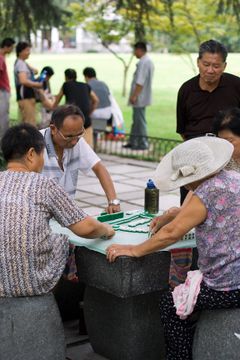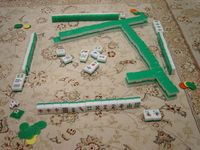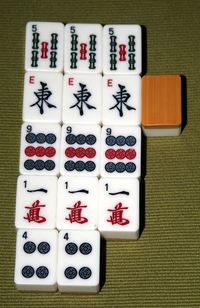ماجونگ
 Mahjong players in Hangzhou in 2006 | |
| الأصناف | Mind sport Tile-based game Abstract strategy game |
|---|---|
| اللاعبون | 3 or 4 |
| زمن الإعداد | 1–5 minutes |
| زمن اللعب | Dependent on variation or rules |
| الفرصة العشوائية | Moderate |
| المهارات المطلوبة | Tactics, observation, memory, adaptive strategies |
| ماجونگ | |||
|---|---|---|---|
 "Mahjong" in Traditional (top) and Simplified (bottom) Chinese characters | |||
| الاسم الصيني | |||
| الصينية التقليدية | 麻將 | ||
| الصينية المبسطة | 麻将 | ||
| |||
| Original/Southern Name | |||
| الصينية التقليدية | 麻雀 | ||
| الصينية المبسطة | 麻雀 | ||
| المعنى الحرفي | little sparrows | ||
| |||
| Vietnamese name | |||
| Vietnamese | mạt chược | ||
| Thai name | |||
| Thai | ไพ่นกกระจอก | ||
| RTGS | phai nok krachok | ||
| Korean name | |||
| هانگول | 마작 | ||
| هانچا | 麻雀 | ||
| |||
| Japanese name | |||
| كانجي | 麻雀 | ||
| كانا | マージャン | ||
| |||
| ملايو name | |||
| ملايو | Mahjung | ||
| إندونيسية name | |||
| إندونيسية | Mahyong | ||
ما جونغ، ماه جونغ ( /mɑːˈdʒɒŋ/ mah-JONG, Mandarin: [mɑ̌.tɕjɑ̂ŋ]) هي لعبة صينية تشبه الدومينو، تم إدخالها إلى الغرب في سنوات العشرينيات.
القطع
تلعب الماجونغ بواسطة قطع صغيرة تسمى القراميد، على شكل قطع دومينو مرسوم على أحد طرفيها أشكال مختلفة . تتألف اللعبة من 144 قطعة، مقسمة على الطريق التالية:
- القراميد الـ107 العادية، وتتألف من:
- أربع مجموعات من 9 قطع بامبو (36 في المجموع).
- 4 مجموعات من الدوائر مرقمة من 1 على 9 (36 في المجموع).
- 4 مجموعات ثم 9 مقاطع لحروف صينية (36 مجموعة).
- مجموعة التشريفات العادية (4 تنانين حمراء، 4 تنانين خضراء و 4 تنانين بيضاء).
- مجموعة التشريفات العليا (4 رياح شمالية، 4 رياح جنوبية، 4 رياح غربية و4 رياح شرقية).
- وأخيرا مجموعة التشريفات المطلقة (4 زهور، 4 فصول).
قواعد اللعبة
تختلف قواعد اللعبة حسب البلد والثقافة. يشارك أربعة لاعبين في الماه جونغ. جرت العادة أن يحمل كل لاعب اسما من أسماء الرياح، شمالية، شرقية، جنوبية أو شرقية. لم يتبق من هذه العادة اليوم إلا اسم الرياح الشرقي. يتم خلط القطع ثم يشكل اللاعبون سورا من 18 قرميدة مقسمة طوليا على صفين. يتم وضع القطع على ظهرها حتى لا تظهر الأشكال المرسومة. يجب أن تؤلف الجدران الأربعة في النهاية شكلا مربعا. يتم تحديد الموضع الذي تستحدث فيه الثغرة في الجدار الرباعي. يأخذ كل لاعب قطعة من الجدار، وتستمر اللعبة حتى يجمع أحدهم 14 قطعة (ويكون عند الآخرين 13 قطعة).
هدف اللعبة هو تشكل ما يسمي "اليد"، أي تشكيلة من ثلاث إلى أربع قراميد متشابهة أو سلسلة من الأرقام المتتابعة. يأخذ كل لاعب قطعة من الجدار الرباعي ويضيفها إلى تشكيلته، ثم يقوم بإعادة قطعة من قطعه إلى الجدار. في بعض الأحيان يقوم اللاعبون الآخرين بالتقاط القطع التي يتخلى عنها غيرهم لاستكمال تشكيل اليد. يعتبر اللاعب اذي يكمل تشكيلته أولا هو الرابح، ويتوجب على الآخرين أن يدفعوا له مقدار اللعبة التي في يده,.يتم تقييد النتيجة على ورقة خاصة.
Glossary
| English | Chinese | Japanese | Comment |
|---|---|---|---|
| Simples | simplified Chinese: 数牌; traditional Chinese: 數牌; pinyin: shùpái; Jyutping: sou3paai2 | اليابانية: 数牌 | |
| Bamboo (sticks) | Chinese: 索子; pinyin: suǒzi; Jyutping: sok3zi2 | اليابانية: 索子 | Originally means bar of 100 pence. |
| Dots (Circles, Wheels, Stones) |
Chinese: 筒子; pinyin: tǒngzi; Jyutping: tung4zi2 simplified Chinese: 饼子; traditional Chinese: 餅子; pinyin: bǐngzi |
اليابانية: 筒子 | Originally meant pennies. |
| Characters Numbers Myriads |
simplified Chinese: 万子; traditional Chinese: 萬子; pinyin: wànzi; Jyutping: maan6zi2 | اليابانية: 萬子 | Originally means 10000 pence. |
| Honors | Chinese: 字牌; pinyin: zìpái; Jyutping: zi6paai2 Chinese: 番子; pinyin: fānzi; Jyutping: faan1zi2 |
اليابانية: 字牌 | |
| Winds | simplified Chinese: 风牌; traditional Chinese: 風牌; pinyin: fēngpái; Jyutping: fung1paai2 | اليابانية: 風牌 | |
| Dragons | Chinese: 箭牌; pinyin: jiànpái; Jyutping: zin3paai2 | اليابانية: 三元牌; literally: "three fundamental" | |
| White dragon | Chinese: 白板; pinyin: báibǎn; Jyutping: baak6baan2; lit. 'blank tile/to be stone-broke' | اليابانية: 白 | |
| Red dragon | Chinese: 中; pinyin: zhōng; Jyutping: zung1; lit. 'center or middle' simplified Chinese: 红中; traditional Chinese: 紅中; pinyin: hóngzhōng; Jyutping: hung4zung1; lit. 'red center' |
اليابانية: 中 | Originally a fifth Wind.[1] |
| Green dragon | Chinese: 發; pinyin: fā; Jyutping: faat3; lit. 'fortune tile' Chinese: 發財; pinyin: fācái; Jyutping: faat3coi4; lit. 'to get rich' |
اليابانية: 發 | Entered the set by 1890.[2][3] |
| Chow | simplified Chinese: 顺子; traditional Chinese: 順子; pinyin: shùnzi; Jyutping: seon6zi2 | اليابانية: 順子 | Run of three tiles from the same suit. |
| Pong | Chinese: 刻子; pinyin: kèzi; Jyutping: haak1zi2 | اليابانية: 刻子 | Three identical tiles (three of a kind). |
| Kong | simplified Chinese: 杠子; traditional Chinese: 槓子; pinyin: gàngzi; Jyutping: gong3zi2 | اليابانية: 槓子 | Four identical tiles (four of a kind). |
| concealed Kong (hidden Kong) |
simplified Chinese: 暗杠; traditional Chinese: 暗槓; pinyin: àn gàng; Jyutping: am3gong3 | اليابانية: 暗槓子 | |
| (forming a Chow from discard) | (Mandarin) Chinese: 吃; pinyin: chī (Cantonese) Chinese: 上; Jyutping: soeng6 |
اليابانية: チー | |
| (forming a Pong from discard) | Chinese: 碰; pinyin: pèng; Jyutping: pung3 | اليابانية: ポン | |
| (forming a Kong) | simplified Chinese: 杠; traditional Chinese: 槓; pinyin: gàng; Jyutping: gong3 | اليابانية: カン | |
| calling Mahjong | (Mainland China) Chinese: 和; pinyin: hú (Taiwan) Chinese: 胡; pinyin: hú (Cantonese) Chinese: 食糊; Jyutping: sik6wu4 |
اليابانية: 和了 اليابانية: アガリ |
Declaring a completed hand. |
| Self-draw (from the wall) |
Chinese: 自摸; pinyin: zìmō; Jyutping: zi6mo1 | اليابانية: ツモ or 自摸 اليابانية: 自摸和 |
Drawing the tile from the wall required to complete a legal hand on one's turn. |
| (calling Mahjong from a discard) | اليابانية: ロン اليابانية: 栄和 اليابانية: 出和了り |
||
| (discarding a tile from which another player calls mahjong) | (Mandarin) Chinese: 放炮; pinyin: fàngpào (Cantonese) simplified Chinese: 出冲; traditional Chinese: 出衝; Jyutping: ceot1cung1 |
اليابانية: 放銃 اليابانية: 振り込み اليابانية: 当たり |
|
| ready hand | (Mandarin) simplified Chinese: 听牌; traditional Chinese: 聽牌; pinyin: tīngpái (Cantonese) Chinese: 叫糊; Jyutping: giu3wu4 |
اليابانية: テンパイ or 聴牌 | A hand that is one tile away from winning. |
| false Mahjong | (Mainland China) Chinese: 诈和; pinyin: zhàhú (Taiwan) Chinese: 詐胡; pinyin: zhàhú (Cantonese) Chinese: 詐糊; Jyutping: zaa3wu4 |
اليابانية: 錯和 | Calling mahjong without a legal hand. |
| short hand | Chinese: 小相公; pinyin: xiǎoxiànggōng; Jyutping: siu2soeng3gung1 | اليابانية: 少牌 | Having too few tiles to win (e.g. if a player forgets to draw a tile after declaring a kong). In literal Chinese: "small husband". |
| long hand | Chinese: 大相公; pinyin: dàxiànggōng; Jyutping: daai6soeng3gung1 | اليابانية: 多牌 | Having too many tiles to win (e.g. if a player draws a tile by mistake after calling a pong from a discard). In literal Chinese: "big husband". |
| draw (goulash) |
Chinese: 流局; pinyin: liújú; Jyutping: lau4guk6 الصينية التقليدية: 荒莊; الصينية المبسطة: 荒庄; پنين: huāngzhuāng |
اليابانية: 流局 | When no players has won the round. |
- Heavenly Hand (天糊)
- Great Winds (大四喜)
- Great Dragons (大三元)
- All Kongs (十八羅漢)
- All Honor Tiles(字一色)
- Thirteen Orphans (十三幺)
- Nine Gates Hand (九蓮宝燈)
- Self Triplets (四暗刻)
- All in Triplets (對對糊)
- Mixed one suit (混一色)
- All one suit (清一色)
- Common Hand (平糊)
- Small Dragons (小三元)
- Small Winds (小四喜)
Unicode
Mahjong tiles were added to the Unicode Standard in April, 2008 with the release of version 5.1.
The Unicode block for Mahjong tiles is U+1F000–U+1F02F:
See also
- Mahjong tiles
- Games played with Mahjong equipment
- Mahjong video game
- Singaporean Mahjong scoring rules
- Khanhoo
- Madiao
- Chinese playing cards
References
Notes
- ^ خطأ استشهاد: وسم
<ref>غير صحيح؛ لا نص تم توفيره للمراجع المسماةStanwick1 - ^ خطأ استشهاد: وسم
<ref>غير صحيح؛ لا نص تم توفيره للمراجع المسماةLo - ^ Stanwick, Michael (2006). "Mahjong(g), before and after Mahjong(g): Part 2". The Playing-Card. 35 (1): 27–39.
{{cite journal}}: Invalid|ref=harv(help)
Further reading
- Lo, Amy. The Book of Mahjong: An Illustrated Guide. Tuttle Publishing: 2001.
- Zhou, H. X. & Wang, Y. L. (2002). The Origin and Development of Mahjong. Journal Of Ningbo University(Liberal Arts Edition)
- Rep, J. (2007). The great mahjong book: History, lore and play. North Clarendon, VT: Tuttle Pub.ISBN 0-8048-3302-8.
- Oxfeld, Ellen, Blood, Sweat, and Mahjong: Family and Enterprise in an Overseas Chinese Community. Cornell University Press: 1993. ISBN 0-8014-9908-9.
- Pritchard, David B., Teach Yourself mahjong. McGraw-Hill/Contemporary: 2001. ISBN 0-658-02147-8.
- Sloper, Tom., Mah-Jongg: Game of the Orient. Self-published: n.d.
- Wright Patterson Mah Jongg Group, Mah Jongg; Wright-Patterson Rules. Wright Patterson Mah Jongg Group: 1963.
Historical research
- Culin, Stewart, ‘The Game of Ma-Jong, its Origin and Significance’. In: Brooklyn Museum Quarterly, Brooklyn, NY, Vol. XI, 1924, p. 153–168. Also found at; Gamesmuseum.uwaterloo.ca
- Depaulis, Thierry, ‘Embarrassing Tiles: Mahjong and the Taipings’. In: The Playing-Card, Vol. 35, No. 3, 2007, pp. 148 – 153.
- Ebashi, Takashi, ‘Proto Mahjong. Mahjong Tiles in the 19th Century’. In: Mahjong Museum Report, Vol. 5, No.2, Issue 9, April 2005, pp. 14 – 17 (in Japanese).
- Lo, Andrew, ‘China’s Passion for Pai: Playing Cards, Dominoes, and Mahjong’. In: Asian Games: The Art of Contest, Colin Mackenzie and Irving Finkel, eds. Asia Society. 2004. pp. 217–231.
- Greene, M. (2016). The Game People Played: Mahjong in Modern Chinese Society and Culture. Cross-Currents: East Asian History and Culture Review, 5(1), 1–27. doi:10.1353/ach.2016.0001ISBN 0-87848-099-4
- Stanwick, Michael, ‘Mahjong(g) Before Mahjong(g): Part 1’. In: The Playing-Card, Vol. 32, No. 4, 2004, pp. 153–162.
- Stanwick, Michael, ‘Mahjong(g) Before Mahjong(g): Part 2’. In: The Playing-Card, Vol. 32, No. 5, 2004, pp. 206–215.
- Stanwick, Michael, ‘Mahjong(g), Before and After Mahjong(g): Part 1’. In: The Playing-Card, Vol. 34, No. 4, 2006, pp. 259–268.
- Stanwick, Michael, ‘Mahjong(g), Before and After Mahjong(g): Part 2’. In: The Playing-Card, Vol. 35, No. 1, 2006, pp. 27–39.
- Stanwick, Michael and Xu, Hongbing, 'Flowers and Kings: A Hypothesis of their Function in Early Ma Que'. In: The Playing-Card, Vol. 37, No. 1, 2008, pp. 29–40.
- Stanwick, Michael and Xu, Hongbing, 'From Cards to Tiles: The Origin of Mahjong(g)'s Earliest Suit Names'. In: The Playing-Card, Vol. 41, No. 1, 2012, pp. 52–67.
- Wilkinson, William H.,(1890): Published in 1901 as pp 184–194 of Catalogue of the Collection of Playing Cards Bequeathed to the Trustees of the British Museum, F. M. O’Donoghue.
- Wilkinson, William H.,(1893): Published in Culin, Games of the Orient, Tuttle, 1958. First published under the title Korean Games, with Notes on the Corresponding Games of China and Japan, University of Pennsylvania, 1895.
- Wilkinson, William H., ‘Chinese Origin of Playing Cards’, in The American Anthropologist, Volume VIII, 1895, pp. 61–78. Can also be found at; [1]
Chinese classic
- Babcock, Joseph Park, Babcock's Rules for Mah-jongg. Mah-jongg Sales Company of America: 1923.
- Babcock, Smith, Hartman, Work, and Foster, The American Code Of Laws For Mah-Jongg. Standardization Committee: 1924.
- Millington, A.D., Complete Book of Mah Jong. Weidenfeld & Nicolson: 1993. ISBN 0-297-81340-4.
Chinese official
- Competition mahjong Official International Rulebook. Takeshobo: 2002. ISBN 4-8124-0944-6.
- Handbook for the Competitions of the Chinese MaJiang. Organizing Committee of Chinese MaJiang: 2005.
- Hatsune, Mai and Takunori Kajimoto, translation by Ryan Morris World-Class Mahjong with World Champion Mai Hatsune: 2005.
- Pritchard, David B., The New mahjong. Right Way: 2004. ISBN 0-7160-2164-1.
External links
- Mahjong at the Open Directory Project
- Mahjong on BoardGameGeek
- Short description is different from Wikidata
- Use dmy dates from March 2014
- Articles containing صينية-language text
- Articles containing ڤيتنامية-language text
- Articles containing تايلندية-language text
- Articles containing كورية-language text
- Articles containing ملايو (لغة كبرى)-language text
- Articles containing إندونيسية-language text
- Articles containing simplified Chinese-language text
- Articles containing traditional Chinese-language text
- Pages using template Zh with sup tags
- Articles containing Chinese-language text
- Articles with hatnote templates targeting a nonexistent page
- Mahjong
- Chinese games
- Gambling games
- Traditional board games
- مقالات تحتوي مقاطع ڤيديو
- 1920s fads and trends
- ألعاب تقليدية
- ثقافة صينية


